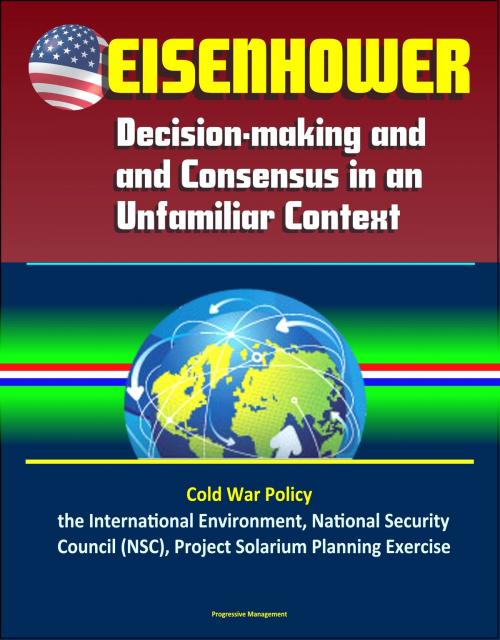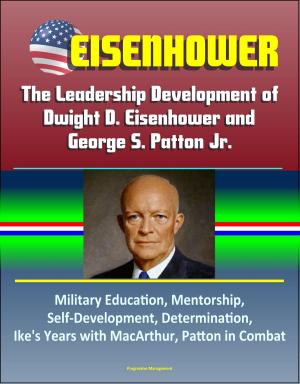Eisenhower: Decision-making and Consensus in an Unfamiliar Context – Cold War Policy, the International Environment, National Security Council (NSC), Project Solarium Planning Exercise
Nonfiction, History, Military, Nuclear Warfare, United States| Author: | Progressive Management | ISBN: | 9781370533961 |
| Publisher: | Progressive Management | Publication: | February 19, 2017 |
| Imprint: | Smashwords Edition | Language: | English |
| Author: | Progressive Management |
| ISBN: | 9781370533961 |
| Publisher: | Progressive Management |
| Publication: | February 19, 2017 |
| Imprint: | Smashwords Edition |
| Language: | English |
This excellent report has been professionally converted for accurate flowing-text e-book format reproduction. This monograph examines the process by which Dwight D. Eisenhower developed his administration's national security policy, and the lessons that it presents for planners. Eisenhower's experiences provide examples of modern design theory in action, particularly managing the interests of multiple stakeholders, building consensus, and confronting complex problems. The study begins by establishing Eisenhower's experience with planning, and provides the context for his development of national security strategy. The creation of a National Security Council, provided many of the foundational materials for Eisenhower's national security strategy. Project Solarium, a planning exercise directed by Eisenhower during the creation of his administration's national security policy, illustrates an approach to systematically design solutions to complex problems, and gain commitment from all participants.
Eisenhower's actions provide examples of modern design theory in action, particularly confronting complex problems, managing the interests of multiple stakeholders, and building consensus. Eisenhower possessed several remarkable attributes, and many books exist that laud his military acumen and political skill. Time will be spent establishing Eisenhower's experience with planning; however, this is not a substitute for those other works, or a summary biography on Eisenhower. The period occupied by Eisenhower's Presidential Administration offers parallels with our time in that it exemplifies an era of dramatic change and uncertainty. One notable effort by Eisenhower's predecessors, the creation of a National Security Council, provided the foundation for Eisenhower's national security strategy development. Project Solarium, a planning exercise directed by Eisenhower during the creation of his administration's national security policy, resulted in National Security Council memorandum 162/2. It illustrates an approach to systematically design solutions to complex problems, and gain commitment from all participants. By assessing the effects of Eisenhower's policy on the US, one may determine the accuracy and suitability of the resulting policy given the situation and its context.
Modern scholars argue that Eisenhower's policy and decision-making mechanism produced comprehensive and successful strategy. Raymond Millen, a Security Sector Reform analyst and Army War College professor asserted, "[the] Eisenhower Presidency was unique in its approach to formulating national security policy and the only administration to publish a comprehensive basic national security policy." Andrew Goodpaster, the Supreme Allied Commander, Europe from 1969-1974, and participant in the Solarium Project, wrote, "[Eisenhower] developed the first coherent and sustainable cold war strategy suitable for basic conditions that would prevail during the following decades." Michele Flournoy, former Undersecretary of Defense for Policy from 2009-2012, commended Eisenhower's Solarium Project as "An example of a truly inclusive and integrated process of long-term strategic planning in the executive branch." Eisenhower's planning and decision-making process can educate a new generation of planners, and also illustrate an approach to planning that exemplifies ideas inherent in design theory.
This excellent report has been professionally converted for accurate flowing-text e-book format reproduction. This monograph examines the process by which Dwight D. Eisenhower developed his administration's national security policy, and the lessons that it presents for planners. Eisenhower's experiences provide examples of modern design theory in action, particularly managing the interests of multiple stakeholders, building consensus, and confronting complex problems. The study begins by establishing Eisenhower's experience with planning, and provides the context for his development of national security strategy. The creation of a National Security Council, provided many of the foundational materials for Eisenhower's national security strategy. Project Solarium, a planning exercise directed by Eisenhower during the creation of his administration's national security policy, illustrates an approach to systematically design solutions to complex problems, and gain commitment from all participants.
Eisenhower's actions provide examples of modern design theory in action, particularly confronting complex problems, managing the interests of multiple stakeholders, and building consensus. Eisenhower possessed several remarkable attributes, and many books exist that laud his military acumen and political skill. Time will be spent establishing Eisenhower's experience with planning; however, this is not a substitute for those other works, or a summary biography on Eisenhower. The period occupied by Eisenhower's Presidential Administration offers parallels with our time in that it exemplifies an era of dramatic change and uncertainty. One notable effort by Eisenhower's predecessors, the creation of a National Security Council, provided the foundation for Eisenhower's national security strategy development. Project Solarium, a planning exercise directed by Eisenhower during the creation of his administration's national security policy, resulted in National Security Council memorandum 162/2. It illustrates an approach to systematically design solutions to complex problems, and gain commitment from all participants. By assessing the effects of Eisenhower's policy on the US, one may determine the accuracy and suitability of the resulting policy given the situation and its context.
Modern scholars argue that Eisenhower's policy and decision-making mechanism produced comprehensive and successful strategy. Raymond Millen, a Security Sector Reform analyst and Army War College professor asserted, "[the] Eisenhower Presidency was unique in its approach to formulating national security policy and the only administration to publish a comprehensive basic national security policy." Andrew Goodpaster, the Supreme Allied Commander, Europe from 1969-1974, and participant in the Solarium Project, wrote, "[Eisenhower] developed the first coherent and sustainable cold war strategy suitable for basic conditions that would prevail during the following decades." Michele Flournoy, former Undersecretary of Defense for Policy from 2009-2012, commended Eisenhower's Solarium Project as "An example of a truly inclusive and integrated process of long-term strategic planning in the executive branch." Eisenhower's planning and decision-making process can educate a new generation of planners, and also illustrate an approach to planning that exemplifies ideas inherent in design theory.















